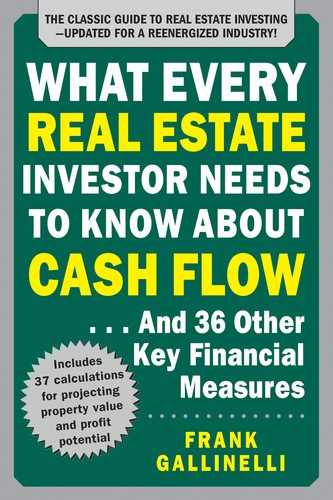CHAPTER 26
Calculation 20: Price, Income, and Expenses per Unit
What It Means
Like several other measurements we’ve discussed, these are not offered for their sophistication or insight. Some investors and brokers still use these, and for that reason, it’s essential that you know what they mean.
And they mean exactly what they say. Take a property’s price, gross scheduled income, or total operating expenses and divide that amount by the number of rental units. For example, if a building has 20 rental units and is offered at $400,000, then its price is $20,000 per unit.
Those who use this technique usually do so only with residential properties (i.e., apartment complexes) because the units in such properties tend to be more uniform in their ability to generate revenue. You commonly rent commercial property by the square foot, and so “per-unit” specifications are generally meaningless. Consider a shopping center with two anchor tenants and 50 smaller tenants. To describe the center as 52 units conveys no useful information.
How to Calculate
Price per unit = price / number of rental units
Income per unit = Gross Scheduled Income / number of rental units
Expenses per unit = Operating Expenses / number of rental units
Example
A building contains 30 apartments each rented at $1,000 per month. Its annual operating expenses are $210,000. The building is offered for sale at $1.5 million. What are its price, income, and expenses per unit?
Price per unit = price / number of rental units
Price per unit = 1,500,000 / 30
Price per unit = 50,000
Thirty rental units at $1,000 per month times 12 months yields a gross scheduled income of $360,000.
Income per unit = Gross Scheduled Income / number of rental units
Income per unit = 360,000 / 30
Income per unit = 12,000
Expenses per unit = Operating Expenses / number of rental units
Expenses per unit = 210,000 / 30
Expenses per unit = 7,000
Test Your Understanding
Building A has 20 apartments. Half are rented at $1,000 per month, the rest at $1,200 per month. The buildings next door and across the street are each for sale at $30,000 per unit. Based on these buildings, what would you expect the owner of Building A to ask for her property?
Answer
If you apply the price-per-unit approach, then Building A has 20 units, and the other properties have established a pattern of asking $30,000 per unit. On that basis, you would expect the owner of Building A to ask 20 times 30,000, or $600,000. Note that the apartments’ income plays no role in setting this asking price.
